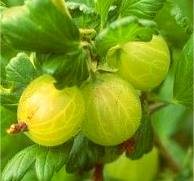Gooseberry
The Gooseberry (Ribes grossularia) gets its name from krüsbar, which signifies a cross, in allusion to the triple spine of the fruit or berry, which is commonly cruciform. This is a relic of its first floral days, preserved like the apron of the blacksmith at Persia, when he came to the throne. The term grossulariaimplies a resemblance of the fruit to grossuli, small unripe figs.
Added Jul 20, 2010
| 8,374 Reads
Frequently the Gooseberry shrub, which belongs to the same natural order as the Currant (Ribes), grows wild in the hedges and thickets of our Eastern counties, bearing then only a small, poor berry, and not supposed to be of native origin. In East Anglia Gooseberry is named Fabe, Feap, Thape, or Theab berry, probably by reason of a mistake which arose through an incorrect picture. The Melon, in a well-known book of Tabernaemontanus, was figured to look like a large gooseberry, and was headed, Pfebe. And this name was supposed by some wiseacre to be that of the gooseberry, and thus became attached to the said fruit. Loudon thinks it signifies Feverberry, because of the cooling properties possessed by the gooseberry, which is scarcely probable. In Norfolk, the green, unripe fruit is called Thape, and the schoolboys in that county well know Thape pie, made from green Gooseberries. The French call the fruit Groseille, and the Scotch, Grosert. It contains, chemically, citric acid, pectose, gum, sugar, cellulose, albumen, mineral matter, and water. The quantity of flesh-forming constituents is insignificant. Its pectose, under heat, makes a capital jelly. In this country, the Gooseberry was first cultivated at the time of the Reformation, and it grows better in Great Britain than elsewhere, because of the moist climate. The original fruit occurred of the hairy sort, like Esau, as the Uva crispa of Fuschius, in Henry the Eighth's reign; and there are now red, white, and yellow cultivated varieties of the berry. When green and unripe, Gooseberries are employed in a sauce, together with bechamel, and aromatic spices, this being taken with mackerel and other rich fish, as an acid corrective condiment. Also, from the juice of the [225] green fruit, "which cureth all inflammations," may be concocted an excellent vinegar. Gooseberry-fool, which comes to our tables so acceptably in early summer, consists of the unripe fruit foulé (that is, crushed or beaten up) with cream and milk. Similarly the French have a foulé des pommes, and a_ foulé des raisins_. To "play old Gooseberry" with another man's property is conjectured to mean smashing it up, and reducing it, as it were, to Gooseberry-fool. The young and tender leaves of the shrub, if eaten raw in a salad; drive forth the gravel. And from the red Gooseberry may be prepared an excellent light jelly, which is beneficial for sedentary, plethoric, and bilious subjects. This variety of the fruit, whether hairy or smooth, is grown largely in Scotland, but in France it is little cared for. The yellow Gooseberry is richer and more vinous of taste, suiting admirably, when of the smooth sort, for making Gooseberry wine; which is choice, sparkling, and wholesome, such as that wherewith Goldsmith's popular Vicar of Wakefield used to regale Farmer Flamborough and the blind piper, having "lost neither the recipe nor the reputation." They were soothed in return by the touching ballads of Johnny Armstrong's Last Good Night, and Cruel Barbara Allen. Gooseberry Shows are held annually in Lancashire, and excite keen competition; but after exhibition, the successful berries are "topped and tailed," so as to disqualify them from being shown elsewhere. Southey, in The Doctor, speaks about an obituary notice in a former Manchester newspaper, of a man who "bore a severe illness with Christian fortitude, and was much esteemed among Gooseberry growers." Prizes are given for the biggest and heaviest berries, which are produced with immense pains as to manuring, and the growth of cool chickweed around the roots of the bushes. At the same time each promising berry is kept submerged in a shallow vessel of water placed beneath it so as to compel absorption of moisture, and thus to enlarge its size. Whimsical names, such as "Golden Lion," "The Jolly Angler," and "Crown Bob," etc., are bestowed on the prize fruit. Cuttings from the parent plant of a prize Gooseberry become in great request; and thus the pedigree scions of a single bush have been known to yield as much as thirty-two pounds sterling to their possessor. The Gooseberry Book is a regular Manchester annual. A berry weighing as heavy as thirty-seven penny-weight has been exhibited; and a story is told of a Middleton weaver, who, when a thunder-storm was gathering, lay awake as if for his life, and at the first patter of rain against the window panes, rushed to the rescue of his Gooseberry bushes with his bed quilt. Green Gooseberries will help to abate the strange longings which sometimes beset pregnant women. In Devon the rustics call Gooseberries "Deberries," and in Sussex they are familiarly known to village lads as Goosegogs. An Irish cure for warts is to prick them with a Gooseberry thorn passed through a wedding ring. By some subtle bodily action wrought through a suggestion made to the mind, warts undoubtedly disappear as the result of this and many another equally trivial proceeding; which being so, why not the more serious skin affections, and larger morbid growths? The poet Southey wrote a Pindaric Ode upon a Gooseberry "And didst thou scratch thy tender arms,
Added Jul 20, 2010
| 8,374 Reads
Share The Magic ...
The GoE MONEY!!! Course - A Course In Real MONEY MAGIC!
|





















